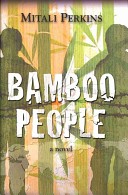
Bamboo People
Written by Mitali Perkins
Charlesbridge, 2010, 272 pp.
ISBN: 978-1580893282
Bamboo People takes place in modern-day Burma (Myanmar) where there is political upheaval between the Burmese people and ethnic minorities in that country, specifically the Karenni people. The first part of the book is narrated by Chiko, a Burmese boy, who aspires to be a teacher to make a difference in the world. With his father in prison for resisting the government, Chiko answers a call in a newspaper to help his family. Unfortunately he discovers he has been tricked along with other applicants to be a boy soldier in the Burmese army. He is pressed into the army and bused to a remote camp in the border region to put down a Karenni rebellion. Chiko’s reading and writing skills help him endure a cruel army captain and brutal conditions. He is eventually captured by the Karenni rebels who send him to refugee camp in Thailand where he awaits their decision on whether he will be killed, kept captive, or released. The second half of the book is told by Tu Reh, a Karenni boy, who is involved in Chiko’s capture. Tu Reh is forced to live in a refugee camp after Burmese soldiers burn down his family’s home and is consumed by anger and the desire for revenge. He is chosen for a military mission as part of his people’s resistance movement. Chiko and Tu Reh’s stories artfully come together when both are sent on their first mission into the jungle and Tu Reh has to make a difficult decision, “Who is his enemy?”
Lengthy back matter includes insights about modern Burma and “What’s in a name?” in addition to an informative author’s note and acknowledgements. Readers will learn additional historical and contemporary information about Burma by accessing a website with resources, a teacher’s guide and suggestions for involvement. In the author’s note Mitali Perkins shares that she lived in Thailand, next door to Burma, for three years, and visited the Karenni refugee camps along the Thai-Burma border. On the website, she states that she was astounded by how the Karenni kept their hopes alive despite incredible loss, dreaming of the day when they would once again be a free people. She was impressed with how the Karenni creatively used the bamboo plant for all kinds of purposes, including transportation, weapons, food, storage, and irrigation, and so decided to use the plant as a symbol for the peoples of that region. Her interactions with Burmese teenagers made her aware of their difficulties as well because of the lack of schooling and jobs and the realization that, for many young boys, being a soldier is their only option to feed their families. Perkins notes that all of us face powerful negative emotions, but also face choices in acting on them. See www.bamboopeople.org for more information.
This riveting novel shares the horrors of war, the oppression of ethnic minorities, the lives of child soldiers from two different sides, and insights into a country that is not familiar to many adolescents. With themes of war, prejudice, child soldiers, friendship, and family, this book could be paired with The Enemy: A Book about Peace (Davide Cali, 2009), A Long Way Gone: Memoirs of a Boy Soldier (Ishmael Beah, 2007), or Daniel Half Human: And The Good Nazi (David Chotjewitz, 2004). Readers may also want to explore other books by Mitali Perkins such as Secret Keeper (2009), Rickshaw Girl (2007) and Monsoon Summer (2006).
Deanna Day, Washington State University, Vancouver, WA
WOW Review, Volume III, Issue 1 by Worlds of Words is licensed under a Creative Commons Attribution-NonCommercial-ShareAlike 4.0 International License. Based on work at https://wowlit.org/on-line-publications/review/iii-1/

This book sounds like I would enjoy it. When I first started reading about it, I thought it was going to remind me of KIRA-KIRA. That book also mixes her native language into the text, but it flows enough that you can too usually figure out what it means through context. For this book, I would like the “aha” chapter titles and the complexity of the circle element. It’s also a good book to add to any collection as it’s always nice to be culturally diverse with your collection.